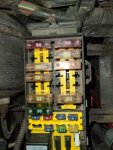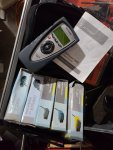I'd forgotten to consider the "Power Distribution Box" (as the manual refers to it), but it turned out that, to my eye, there are no obvious fuses or relays related to the speed control system in there, so I'm not sure what fuse you checked there, but I may have missed something. However, there are at least 2 fuses in there that seem to be related to the ABS. You might want to check those.
Also, if I were you, I'd definitely double-check the
in-cab fuse box. If my downloaded 1997 Ranger owner's manual is correct, fuse
#10 and
#13 are used for "speed control". Please confirm. And don't forget about the 3 aforementioned ABS-related fuses in the in-cab fusebox.Depending on how capable it is, it could definitely be useful. As I frequently remind people, just because there's no CEL (Check Engine Light) illuminated, it doesn't mean that there are no codes!
So, see what your scantool can do. And tell us what brand/model it is. Assuming you have a stand-alone, all-in-one scantool (i.e. as opposed to one where you control the hardware and software, running on a laptop or smartphone/tablet -- which is far more flexible and inexpensive), here are the things that would be useful, ordered from "most likely to be supported in an inexpensive stand-alone scantool" to least likely:
- report "stored" emission-related DTCs (Diagnostic Trouble Codes)
- report "pending" emission-related DTCs
- report standardized PIDs (Parameter IDs)
- report non-emission-related DTCs (transmission, brakes, etc)
- report manufacturer-specific PIDs
VSS is an SAE-standardized PID, so there's a good chance that even a low-end stand-alone scantool will report it.
BPP, unfortunately, is a manufacturer-specific PID, so you're better off with FORScan or Torque Pro or similar, where you get to choose the software.














